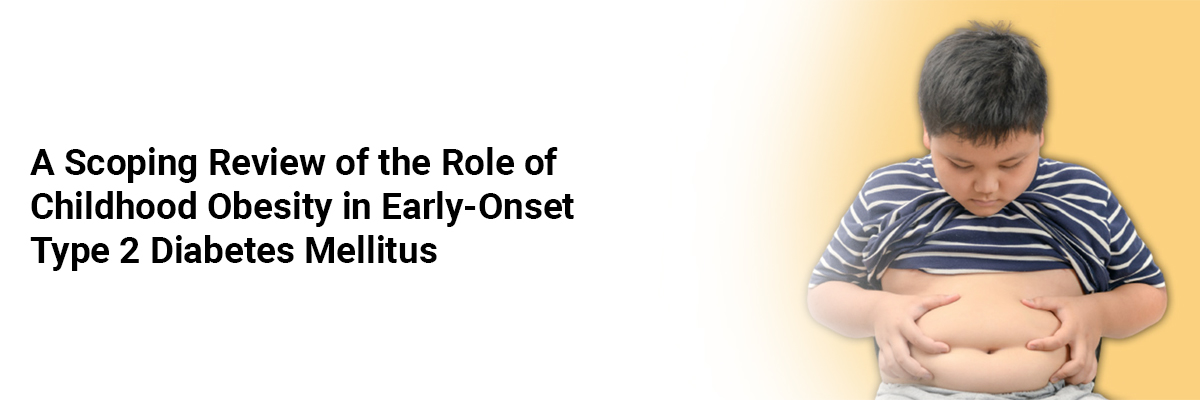
 IJCP Editorial Team
IJCP Editorial Team
A Scoping Review of the Role of Childhood Obesity in Early-Onset Type 2 Diabetes Mellitus
Childhood obesity has become a major global health issue. By
2020, nearly half of children worldwide were predicted to be affected. In
several regions, obesity has even surpassed undernutrition as the primary
health concern.The most alarming aspect is its strong association with the
early onset of type 2 diabetes mellitus (T2DM).
Factors Contributing to Childhood Obesity
According to the Centers for Disease Control and Prevention
(CDC), the causes of excessive weight gain in children are similar to those in
adults. Key contributing factors include:
- Genetic
predisposition
- Environmental
influences
- Poor
dietary patterns
- Cultural
habits
- Metabolic
processes
- Sedentary
lifestyle
- Family
history
Associated Health Risks
Childhood obesity is linked with multiple comorbidities,
such as:
- Type
2 diabetes mellitus
- Hypertension
- Asthma
- Dental issues
- Liver disorders
Research shows that
obese children are four times more likely to develop type 2 diabetes
compared to children with normal body weight.
Early-Onset Type 2 Diabetes: A Growing Threat
Studies reveal that early-onset type 2 diabetes is more
aggressive than later-onset cases. It progresses rapidly and leads to
complications in both small and large blood vessels.
- Around
371 million people globally are affected.
- Predictions
suggest this number may rise to 552 million by 2023, including
children.
Research Insights
A scoping review (2000–2021), following the PRISMA format,
examined the link between childhood obesity and early-onset type 2 diabetes.
- Out
of 3,614 studies, only 17 were included.
- Most
research comes from high-income countries (North America, Asia).
- Limited
studies exist from Africa and Australia, highlighting a global
research gap.
- Poor
lipid profiles and hypertension were common factors linked to obesity.
- Insulin
resistance in adipose tissue is a critical factor in the transition to
diabetes.
The Role of Insulin Resistance
One of the most significant findings is that insulin
resistance develops faster in obese children than in adults.
- Obese
adults may take 10 years or more to develop type 2 diabetes.
- Obese
children may progress in half that time.
Need for Further Research
Although current evidence highlights the strong link between
childhood obesity and early-onset diabetes, limitations exist due to:
- Geographical
variation in data
- Small
sample sizes
- Lack
of prospective and experimental studies
Future research should focus on larger and more diverse populations to better understand the global impact.
FAQs on Childhood Obesity and Early-Onset Type 2 Diabetes
Q1. Why is childhood obesity considered a global health
concern?
Because it increases the risk of
serious diseases like type 2 diabetes, hypertension, and liver disorders at an
early age.
Q2. How much more likely are obese children to develop
type 2 diabetes?
They are about four times more
likely compared to children of normal weight.
Q3. What are the main causes of childhood obesity?
Poor diet, lack of physical
activity, genetics, environmental influences, and family history.
Q4. Why is early-onset type 2 diabetes more dangerous
than adult-onset?
It develops faster, progresses
aggressively, and leads to early complications in blood vessels and vital
organs.
Q5. Which regions have the most research on childhood
obesity and diabetes?
Mostly high-income countries
like the US and Asian nations, while Africa and Australia show limited data.
Q6. What role does insulin resistance play?
Insulin resistance in fat tissue is
the main factor driving the transition from obesity to type 2 diabetes
in children.
Q7. What more needs to be done?
Larger global studies across
different populations are needed to fully understand and address this
rising health crisis.

IJCP Editorial Team
Comprising seasoned professionals and experts from the medical field, the IJCP editorial team is dedicated to delivering timely and accurate content and thriving to provide attention-grabbing information for the readers. What sets them apart are their diverse expertise, spanning academia, research, and clinical practice, and their dedication to upholding the highest standards of quality and integrity. With a wealth of experience and a commitment to excellence, the IJCP editorial team strives to provide valuable perspectives, the latest trends, and in-depth analyses across various medical domains, all in a way that keeps you interested and engaged.



















Please login to comment on this article